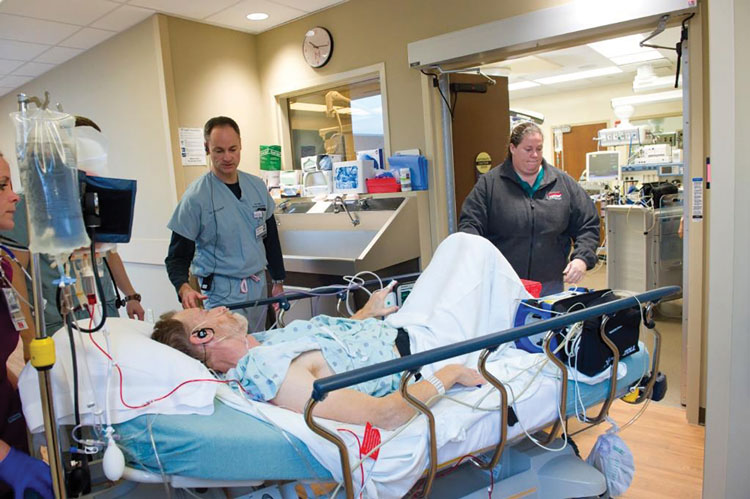Fundamentally Human: Learning By Design
Process/design 2016
A strategic focus for the health system in 2016 was on improving patient engagement and satisfaction, and led the MHQA planning team to include more patient-centered simulations with opportunities for providers to practice the “soft skills” of effective communication with patients and families. The design would include communication tools and tips for providers, as well as sharing immediate feedback from the SPs.
One significant example of the value of immediate SP feedback followed a simulation in late 2015 involving a patient who required immediate surgery for a rupturing abdominal aortic aneurysm. The SP was brought into the large group debrief with the 40 attendees, and asked to share his “patient” perspective of the medical emergency. Despite not actually being ill, the experience felt very real—and in his words, “it was incredibly scary.” Candid feedback was offered, such as needing more explanation about what all the tubes and wires were for as they were being used. The SP noted that third-person discussions about him as was lying there listening felt “weird,” and observed that staff needed to maintain awareness of the patient in the room. This feedback was priceless, as it brought to light the impact of understanding the experience from the patient and family perspective. (Figure 3)

Literature also supports the use of immediate SP feedback. A study by Howley and Martindale (2004) examined the use of SP feedback for first-year medical students participating in their first formal encounter with an SP to complete a patient interview. Their study supported the importance and impact of immediate SP feedback, with an insightful comment from one student: “The feedback was especially important. He [the SP] picked up on little details that I didn’t even notice.”
Linda Kenney, founder of Medically Induced Trauma Support Services (MITSS), was invited to present at the 2016 symposium, and share her experiences as a patient and patient safety advocate. Her presentation was structured to not only include some of her personal experiences with communication and engagement, but also address some key points around the importance of provider identification, open and effective communication; and reporting of safety concerns. A provider reference tool, developed collaboratively with Helen Haskell, founder of Mothers Against Medical Error (MAME), was created for this purpose.
Simulation design began with a scenario originating from the patient experience area of the health system. The patient experience team’s main focus is on customer service relations for patients and families. They provided a true story of poor communication, and how situations could be avoided through better use of listening skills and situational awareness. The simulated scenario involved a patient with a chest tube who was informed by his physician that it would be taken out, allowing him to go home the next day—which did not happen. The MHQA team used a pre-recorded video to show the evolution of treatment and miscommunications during the two days preceding the event.
After viewing the video, teams were pre-briefed with the following objectives:
- Identify barriers to effective communication with the patient
- Utilize enhanced communication techniques discussed in morning presentations
- Demonstrate appropriate communication techniques when explaining the treatment plan
Two members from each team took on the roles of physician and patient experience representative to engage with the patient, while other members observed. The teams entered the room to find an irate SP with a chest tube still present. The SP launched into a very loud outburst while verbalizing several frustrations: no provider came to see him the previous day; his wife drove an hour to come get him but he was not discharged as they expected; he was thirsty and was still waiting for someone to bring him water; and he was now stuck here listening to excuses. The SP demanded to know why the chest tube was still in, and he wanted it out immediately so he could go home (Figure 4). As the provider worked to de-escalate the situation, apologize to the patient, and explain the current treatment plan, the SP repeated his frustrations or became dismissive of the provider. The patient experience representative came to check on the SP but was also dismissed as another person talking but not doing. During the 10-minute simulation, both teams used various communication techniques reviewed during the earlier session—listen carefully and non-judgmentally; encourage the patient to ask questions; use shared decision-making—and the SP responded by talking less, listening more, and starting to calm down.
